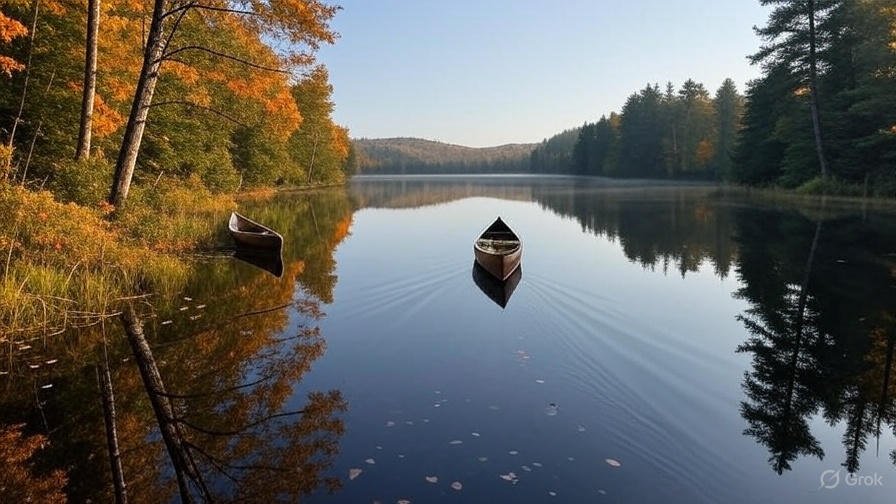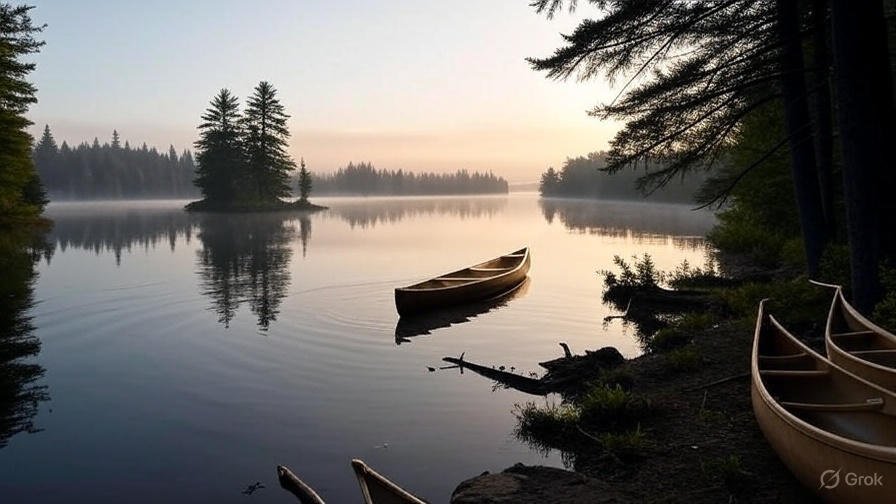Canoe Lake is a pretty place in Algonquin Park, Ontario. The water is calm. Trees are all around. My name is Warren Driscoll. I’ve traveled to cool places for seven years, like big houses in Ibiza and small cabins in the French Alps. Since 2018, I’ve paddled this lake. I write true stories and simple tips to help you have a great trip. This guide shares quiet routes and old tales, based on my trips and study. It’s a personal view, different from websites like TripAdvisor or park pages.
Why Visit This Lake?
This lake is a top spot in Algonquin Park. It’s easy to get to. Even if you’re new to paddling, you can do it. The lake connects to small lakes and rivers with nice views. It has stories about Indigenous people and an artist named Tom Thomson. This guide gives you quiet routes and clear tips for a fun trip, more personal than what you find on other websites.
What Makes This Lake Special?
The lake is on Highway 60 in Algonquin Park. It’s a 2.5-hour drive from Toronto. You can rent canoes at the Portage Store. This area leads to calm spots many people don’t know. While other websites give basic info, I share less-traveled routes and stories from my paddling and research.
Quiet Routes to Paddle
This lake has routes that take you to peaceful places. I’ve paddled three routes with great views and fewer people. Here they are:
Route 1: Canoe Lake to Joe Lake
This is good for a one-day trip. Start at the lake’s spot #5 on Highway 60. Paddle north to a short 400-meter path. This path is flat and easy to walk. Joe Lake is small and calm, with pine trees and clear water. You’ll see a rock with a sign for Tom Thomson, an artist who died on this lake in 1917. Paddle back through Teakettle Lake. The trip takes 3 hours. It’s quieter than the main lake.
Route 2: Canoe Lake to Little Doe Lake
This trip takes two days. Start at the lake. Paddle east to a 1,320-meter path. The path goes uphill, so pack light stuff. Little Doe Lake is wild and quiet. You might see birds called loons or big animals like moose. There are 10 campsites to pick from. Paddle back through Tom Thomson Lake for a new view. This trip takes 6-8 hours, including walking. This route isn’t in many guides, but it’s one of my favorite calm spots.
Route 3: Canoe Lake to Burnt Island Lake
This is for strong paddlers and takes three days. Start at the lake. Paddle south to a 2,390-meter path. The path has rocks, so wear tough shoes. Burnt Island Lake is big with lots of islands, great for camping. The water is clear and good for catching fish like trout. This route isn’t in many guides, making it a quiet escape.
Old Stories of This Lake

This lake has stories that make it special. From park info and books I’ve read, this area is on Anishinaabe land. They used it for travel and trade long before roads were built. In the 1700s, voyageurs paddled here to carry furs. Paddling feels like going back in time. For more, look at resources from Anishinaabe groups or local First Nations.
The Tom Thomson Story
Tom Thomson was an artist who loved this lake. He painted its trees and water. In July 1917, he went missing while paddling. His body was found later in the lake. No one knows how he died. Was it an accident? Something else? A sign on Joe Lake remembers him. I’ve seen this spot, and it feels special. I share what I learned from books, park workers, and my visits, but some parts of the story are still a mystery.
Indigenous and Voyageur History
These stories aren’t always on tourism websites. I learned them from Algonquin Park books and talks with rangers. Anishinaabe people used this area for thousands of years with light canoes. Later, voyageurs used these waters to move furs to far places. These tales make every paddle feel big.
Easy Tips for Your Trip
Planning a trip to this lake is simple with good tips. I’ve paddled here a lot, and these ideas come from my trips.
How to Get There
The lake is at spot #5 on Highway 60, a 2.5-hour drive from Toronto. Leave early to avoid cars near Barrie. There’s free parking by the Portage Store. It has a small restaurant with food like burgers. I’ve driven this road many times. Stop at Tim Hortons in Huntsville for a drink if you want.
Getting Canoes and Gear
The Portage Store rents canoes, kayaks, and life jackets for about $40 a day. They give you a map. Bring your own paddle if you like. Put clothes and food in a waterproof bag. I always check my life jacket to make sure it fits. Wear it all the time. The water can be cold.
Staying Safe
This lake is good for new paddlers, but be safe. Check the weather. Wind can get strong after lunch. Stay near the shore if you’re new. Paths can be muddy, so wear tough shoes. You might see moose or bears—stay far away. I bring a first-aid kit and extra food. Call 911 or 1-833-NYS-RANGERS if you need help.
Camping and Permits
You need a permit to camp. It costs about $12 per person per night. Get it online at the park’s website or call them. Campsites are first-come, first-served. Get there early for a good spot. I like island campsites for quiet. Bring a small tent. Check fire rules before cooking.
Fishing and Wildlife
These waters have fish like brook trout. Get a fishing license at the Portage Store. Use light gear. I caught trout on Burnt Island Lake. You’ll hear loons at night and see beavers by the shore. I saw a moose early on Little Doe Lake. Paddle at sunrise to see animals. Clean your gear so bad plants don’t spread.
Best Time to Visit
Summer (June to August) is warm and good for swimming, but busy. Spring (May) and fall (September) have fewer people. Fall leaves are pretty. I loved them in September. Winter is too cold for paddling. Plan 3-5 days for a big trip. I like spring and fall for quiet.
More Places to Explore
This lake connects to other waters. From Joe Lake, paddle to the French River, an old voyageur path. Burnt Island Lake leads to the Petawawa River, but it’s for strong paddlers. Use the Algonquin Park Canoe Routes Map to plan. I mix day trips with camping for fun.
Stories from Other Places
This lake’s history is like other big waters. The U.S. Forest Service says the Boundary Waters in Minnesota have old Indigenous paths too. The Wisconsin Historical Society says dugout canoes in Lake Mendota are over 4,000 years old. This shows how old this tradition is. These stories make your trip feel big.
Final Thoughts
This quiet corner of Algonquin is more than water. It’s nature and history. Routes like Joe Lake or Burnt Island Lake take you to calm spots. Stories of Anishinaabe people and Tom Thomson make it special. My seven years of travel and paddling shape this guide. Use these tips for a safe, fun trip. Share your stories in the comments to keep the adventure going!
Disclaimer: This guide is based on my own trips, research, and talks with park workers. I try to share helpful tips, but I’m not part of Ontario Parks or any official group. Always check the park’s website for the latest rules, maps, and safety info. Be careful when paddling or camping, and plan ahead. For history, I share what I’ve learned from books and trusted sources, but some stories may have other versions. Please explore with care and respect for nature and local history.
Explore More
- Villas at Princeton Lakes: 2025 Living Guide to Luxury, Costs & Hidden Perks
- Chace Lake Villas Luxury Apartments – Modern 1-3 Bedroom Homes Near Oak Mountain

Warren Driscoll writes about luxury travel. He has over seven years of experience. Since 2018, he has stayed in private villas in Ibiza and Saint-Tropez, and chalets in the French Alps. Warren’s stories have been shared by Indvidual Magazine. He writes honest reviews and gives helpful tips to help people plan great holidays. He also shares his own photos and real experiences to make his advice clear and useful.
